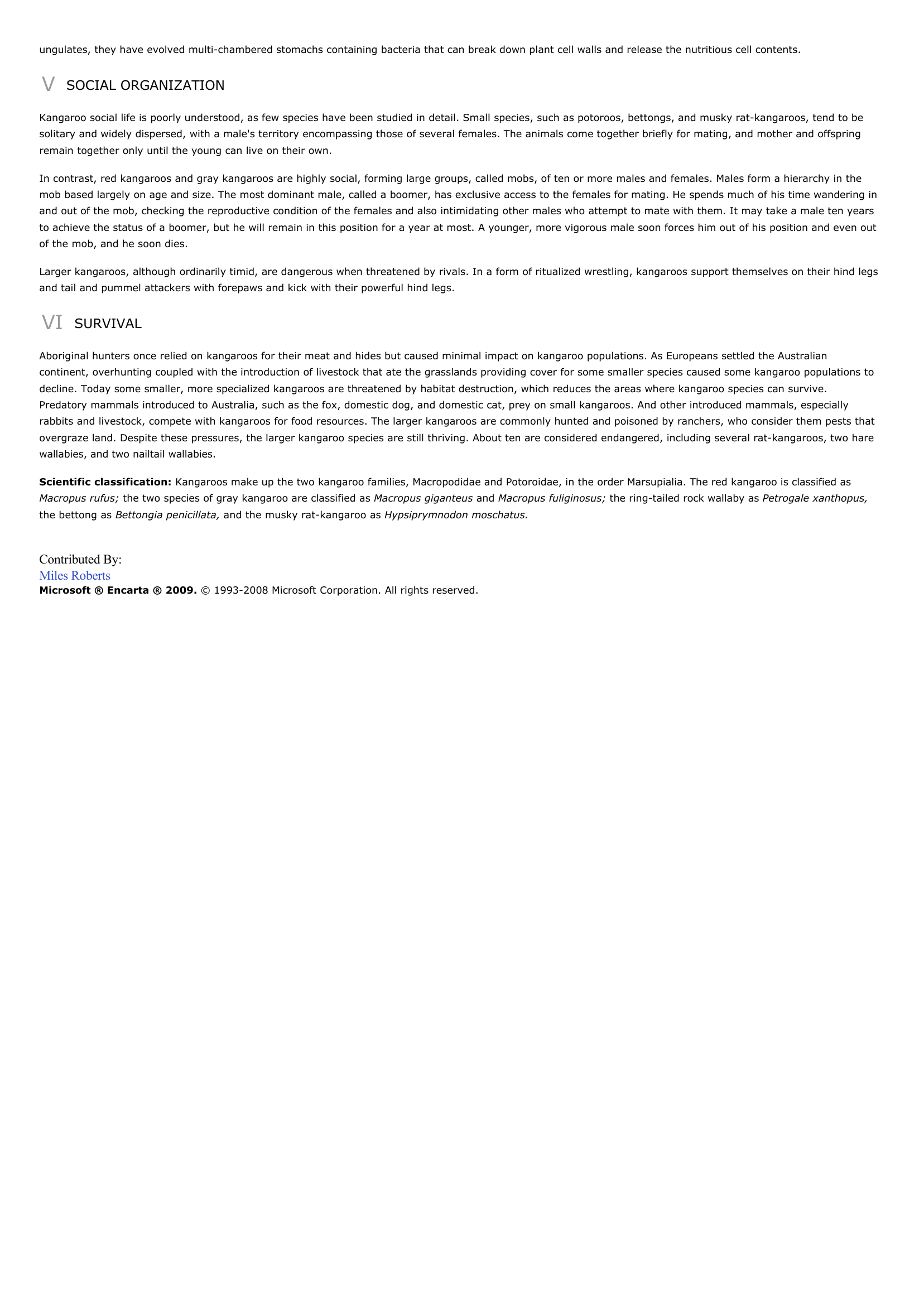Kangaroo - biology.
Publié le 11/05/2013

Extrait du document
«
ungulates, they have evolved multi-chambered stomachs containing bacteria that can break down plant cell walls and release the nutritious cell contents.
V SOCIAL ORGANIZATION
Kangaroo social life is poorly understood, as few species have been studied in detail.
Small species, such as potoroos, bettongs, and musky rat-kangaroos, tend to besolitary and widely dispersed, with a male's territory encompassing those of several females.
The animals come together briefly for mating, and mother and offspringremain together only until the young can live on their own.
In contrast, red kangaroos and gray kangaroos are highly social, forming large groups, called mobs, of ten or more males and females.
Males form a hierarchy in themob based largely on age and size.
The most dominant male, called a boomer, has exclusive access to the females for mating.
He spends much of his time wandering inand out of the mob, checking the reproductive condition of the females and also intimidating other males who attempt to mate with them.
It may take a male ten yearsto achieve the status of a boomer, but he will remain in this position for a year at most.
A younger, more vigorous male soon forces him out of his position and even outof the mob, and he soon dies.
Larger kangaroos, although ordinarily timid, are dangerous when threatened by rivals.
In a form of ritualized wrestling, kangaroos support themselves on their hind legsand tail and pummel attackers with forepaws and kick with their powerful hind legs.
VI SURVIVAL
Aboriginal hunters once relied on kangaroos for their meat and hides but caused minimal impact on kangaroo populations.
As Europeans settled the Australiancontinent, overhunting coupled with the introduction of livestock that ate the grasslands providing cover for some smaller species caused some kangaroo populations todecline.
Today some smaller, more specialized kangaroos are threatened by habitat destruction, which reduces the areas where kangaroo species can survive.Predatory mammals introduced to Australia, such as the fox, domestic dog, and domestic cat, prey on small kangaroos.
And other introduced mammals, especiallyrabbits and livestock, compete with kangaroos for food resources.
The larger kangaroos are commonly hunted and poisoned by ranchers, who consider them pests thatovergraze land.
Despite these pressures, the larger kangaroo species are still thriving.
About ten are considered endangered, including several rat-kangaroos, two harewallabies, and two nailtail wallabies.
Scientific classification: Kangaroos make up the two kangaroo families, Macropodidae and Potoroidae, in the order Marsupialia.
The red kangaroo is classified as Macropus rufus; the two species of gray kangaroo are classified as Macropus giganteus and Macropus fuliginosus; the ring-tailed rock wallaby as Petrogale xanthopus, the bettong as Bettongia penicillata, and the musky rat-kangaroo as Hypsiprymnodon moschatus.
Contributed By:Miles RobertsMicrosoft ® Encarta ® 2009. © 1993-2008 Microsoft Corporation.
All rights reserved..
»
↓↓↓ APERÇU DU DOCUMENT ↓↓↓


















